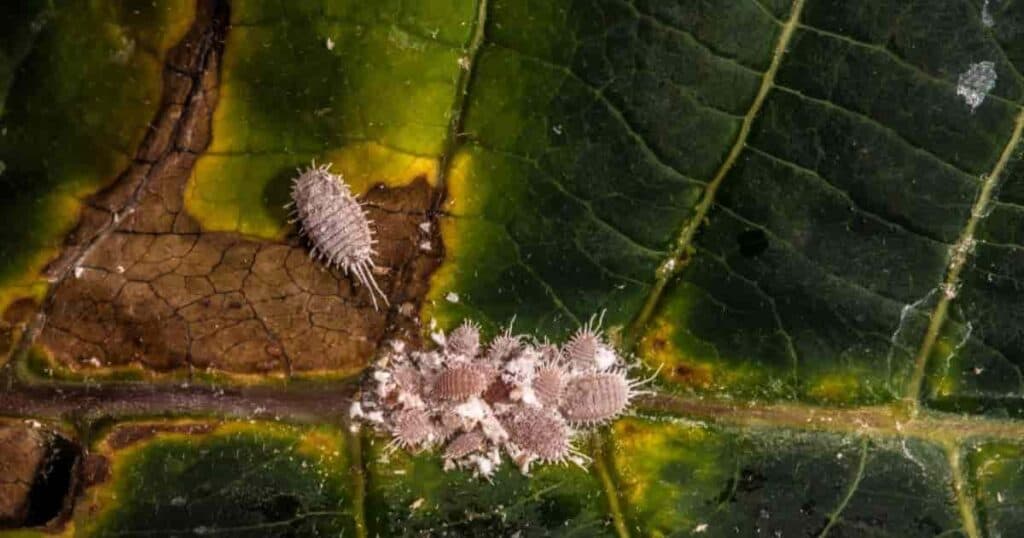Mealybugs are a widespread houseplant pest that can be incredibly frustrating and difficult to eliminate when an infestation occurs. Found almost exclusively indoors mealybugs on houseplants live well in homes and greenhouses.
They do not survive in many places outside because they cannot tolerate freezing temperatures.
How Mealybugs Spread
Mealybugs are almost always brought into the home or greenhouse on new plants brought in from some outside source.
Examples are buying plants from a garden center or receiving a plant from someone as a gift.
The mealybugs on the infested plant will easily spread to other plants.
Once a population is established, it is a battle to get rid of them and save your plants from the damaging effects of mealybugs.
This guide is to help you gain the upper hand not only to remove mealybugs from your prized plants but also to prevent them from becoming an issue in the first place.
Mealybug Identification
There are several species of mealybugs you may encounter while taking care of your houseplants.
However, all mealybugs have similar features that make them easy to recognize and identify from other common pests.
Adult female mealybugs have oval-shaped bodies, no wings, and are covered with white wax with a fuzzy look to them.
They have legs and are mobile, but despite this, they don’t travel very far once they get established, and they do not move very quickly.
Female nymphs are oval and colored yellow, orange or pink. The white accumulating fluffy white wax will increase as they get older.
When they lack the white coating, mealybug nymphs are very mobile, and this is when they will move from an infected plant to a non-infected plant in search of new feeding areas.
Male mealybugs are much different from their female counterparts and are very tiny and gnat-like.
They have wings that they can use to move around and find female mates. They find females to mate with and establish a new population on a plant.
When scouting the plant foliage, they are seldom noticed.
Most people do not notice mealybugs until a largely female population has already become well-established, making them so hard to eliminate.
Mealybug Damage
Mealybugs are puncture and suction feeders, using their piercing-sucking mouthparts to feed on plant juices and sap.
They excrete a waste product from their feeding, a sweet, sticky fluid called honeydew.
Due to the sugary content of this fluid, an ugly black fungus called sooty mold often grows on the honeydew.
The more honeydew there is, the more sooty mold there can be, and this can damage leaves, impede sunlight absorption, and stall out photosynthesis.
This is in addition to the stress of the bugs feeding on the plant’s internal sap and draining it of nutrients.
Heavy mealybug infestations can severely damage the plant and stunt growth.
Small populations of mealybugs often go undetected due to the coloration and small numbers that are easy to hide in leaf crevices.
In most cases, by the time the mealybugs have been identified or damage has been noted, the pests have likely been feeding on the plant for several weeks.
Control Options
Mealybugs dine on a wide array of houseplants but do have their favorites.
Here are various control steps to remember:
Check for mealybugs if you have coleus, ferns, cactus, hoya, palms, jade, orchids, philodendron, ficus, Schefflera, and citrus plants. This must be specifically a part of general plant care.
Carefully scout any plants you bring home and keep an eye on them for a few weeks to ensure no infestation is detected.
If you discover mealybugs on the plants, either quarantine the plant until the infestation is gone or toss the plant out to avoid spreading the infestation to your healthy plants.
If you catch a mealybug infestation early on, you can try washing the leaves and stems by hand to remove the pests. You can do this with a diluted mild dish detergent and water mix.
Use a soft cloth or a very soft toothbrush to remove both the mealybugs and the honeydew by washing the leaves.
Handpicking or using a cotton swab dipped in alcohol may also be effective, though this should be sparingly done as there is a risk that the alcohol will burn the leaves if it is done too frequently.
To eliminate the mealybug, washing and hand removal will also be necessary to ensure all nymphs are removed.
If unsuccessful with the above methods, you could consider using an insecticide.
The bodies of mealybugs and the coating on their eggs make them resistant to many typical spays and chemicals.
They are also very good at hiding in nooks and crannies where sprays and liquid cannot reach easily.
Less toxic options for those worried about the risk to themselves, children, or pets, include insecticidal soap, horticultural oil, and specialized spray formulations.
It is important to note that some systemic insecticides are specially designed for houseplants and mealybugs.
However, these are very expensive and contain the active ingredient imidacloprid, which is effective but highly expensive.
For this reason, this removal method is recommended only for highly valuable plants that cannot easily be replaced.
Closing Thoughts
It can be difficult to get rid of mealybugs once they get established on your houseplants.
For this reason, prevention and proper care is the best way to handle the threat of mealybugs on your prized houseplants.
Source link
Originally posted 2022-09-24 17:25:35.





